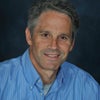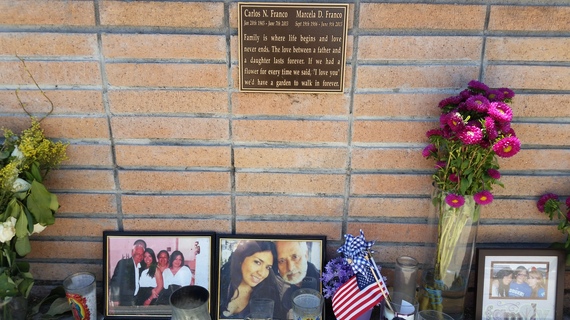Soon after the horrific shooting at the Pulse nightclub in Orlando, fear and paranoia scored a little victory on the opposite side of the country. Or did they?
I was about to walk over to a cozy neighborhood bar to watch Game 5 of the NBA finals - and then got to thinking. The terrifying descriptions of the mass shooting in Orlando were by then pouring in - the gunman blasting his way into the Pulse club, the chaos and confusion on the dance floor, the scattering patrons, the falling bodies, the scramble to escape the building, the restroom stalls that became dubious hideouts of last resort.
With this frightening news fresh in mind, I couldn't help picturing the nearby bar's entrance, a single door on a busy boulevard, and the likely crowd of patrons inside. Many fans would surely be there to watch the game - or would they? Perhaps others were imagining what I was: A man walking in with an assault rifle, firing indiscriminately. There'd be virtually nowhere to run, nowhere to hide. Maybe under one of the pool tables? It's not a large space, which is part of its pub-like charm. There must be a back door...
I could imagine the screams, and the shattering glass as bullets struck rows of liquor bottles, as seen in many a western. It's actually not hard to picture, considering all the shootouts we've seen on TV and in movies. There's also the grim reality we've had to confront after tragedies like the one in Orlando - or San Bernardino, or Roseburg, or Chattanooga. It was only a year ago that Charleston joined the awful list, a list that by then included Newtown, Isla Vista and Aurora, to name just a few locations devastated by mass shootings in recent years.
A "mass shooting," by the way, is by one common standard defined as an incident in which four or more people are killed. By another standard, it's when four or more people are killed or wounded.
I don't know how four became a magic statistic, but by that second standard, mass shootings took place in the U.S. in 2015 more than once a day, on average, a recent New York Times analysis found. But if you count all gun-related homicides, not just those from high-profile mass shootings, 27 Americans are shot dead per day, far more than in any other well-to-do Western democracy, as is often noted (the shocking news about the shooting of a British lawmaker notwithstanding).
But we Americans know that our country can be a uniquely dangerous place, in terms of getting shot. Yet that doesn't stop us from going to bars or clubs or the mall or movie theaters or wherever.
In the name of freedom we cannot be cowed by shootings, mass or otherwise. Paranoia is no panacea. I mean, really, how risky could my visit to a normally friendly neighborhood bar be?
Then again, within hours of the Orlando shooting, Santa Monica police (fortunately) arrested a 20-year-old Indiana man just a few blocks away from the bar. In his white Acura police said they found three assault rifles, one of them on the front seat, plenty of ammunition, and the chemical ingredients to set off quite a destructive explosion. Shades of Boston?
So there was that.
And of course I knew that Santa Monica had already gained a place on America's mass-shooting map, just three years ago, when a 23-year-old man, dressed in black and armed almost as if on a SWAT team, shot and killed his father and brother at their house.
He then forced a woman at gunpoint to drive him the mile west to Santa Monica College, where he let her go but randomly shot and killed a father and daughter in their car as they pulled out of a college parking lot. He also shot and killed a woman collecting recyclables before he died in a gunfight with police outside the college library.
Police said he fired a hundred rounds that afternoon. Had he gone back into the library, where many students had taken cover, it could have been a lot worse - perhaps more like Pulse. Or Virginia Tech, scene of the nation's deadliest shooting rampage - until Orlando.
En route to campus, in the hijacked car, the Santa Monica gunman had sprayed a city bus with a flurry of bullets - within view of the neighborhood bar's front door.
I heard the pop-pop-pop of gunfire around noon that day. It's a startling sound more often heard in other parts of Los Angeles, but there it was.
Soon I was standing behind a police line, assisting Southern California public radio station KPCC with its reporting. One witness I interviewed, understandably shaken, described crossing paths with the shooter - and ducking behind a wall as bullets whizzed past.
A few paces away was the red Ford Explorer that carried the father and daughter, Carlos Franco, 68, and Marcela Franco, who was 26, the youthful age of a lot of the Orlando club-goers. I did not know them, but I am a father, and I have a daughter. I am also human. Their car had crashed into a waist-high brick wall. Carlos died that day, Marcela two days later. The crumbled wall was rebuilt with a memorial plaque affixed - a silent testament to tragedy, American style, adorned today with pictures and flowers.
So my hesitation about going out the other night wasn't just extrapolation. Not only could a shooting like the one in Orlando happen here, it did happen here - on June 7, 2013. And it could happen anywhere, at any time, especially in America.
I never did go to the bar that night. But I wouldn't blame fear or paranoia as much as a profound sense of sadness for those who had needlessly lost their lives in Orlando, like too many others before them, and for their friends and families left to grieve. There were also the wounded, more than 50 of them. It just didn't feel like a good night to go out.
Later, it was heartbreaking to listen to Anderson Cooper read the names of the 49 victims, along with many hastily prepared epitaphs, as their pictures appeared on CNN, one after the other.
You could tell Cooper struggled to suppress his emotions, something you don't often see among top newscasters, even in 2016. It reminded me of how Walter Cronkite, in 1963, uncharacteristically appeared to fight back tears the day he announced on CBS that President Kennedy, who had been shot less than an hour earlier, had died.
People are already talking about reopening Pulse, although that may not be a simple matter, as has been learned at other sites shattered by gunfire. But I will go back to the old neighborhood bar soon enough, to do the sort of thing free people do, with haunting thoughts of becoming unwitting targets in the next mass shooting - or any shooting - kept deftly in check.

